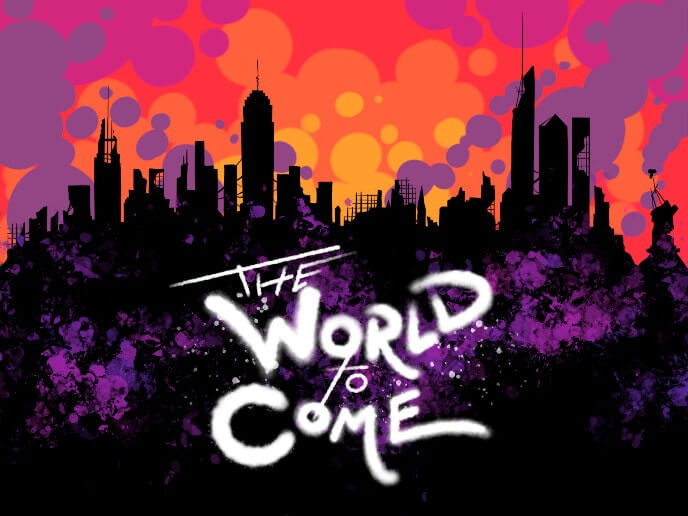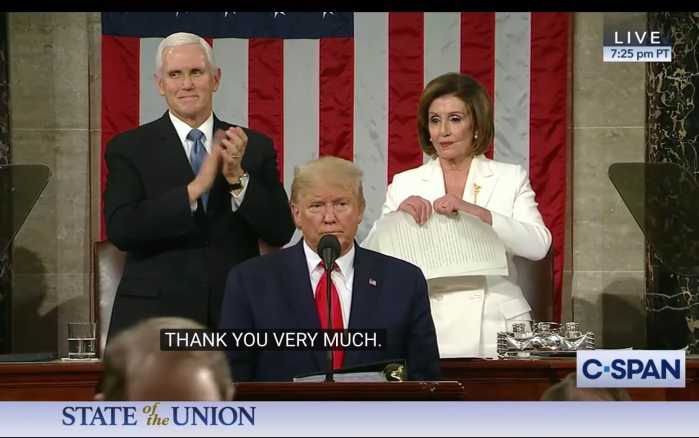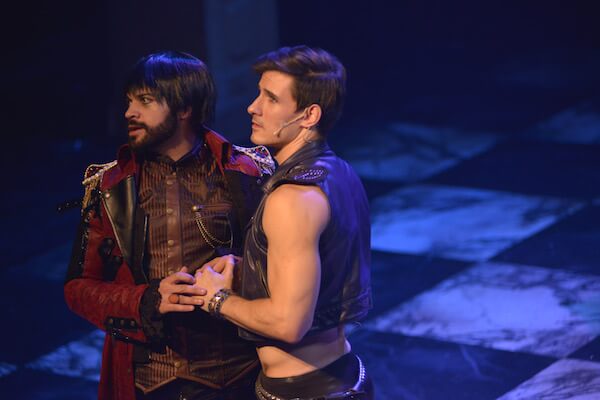Many of us are grieving over the protracted pause of Broadway and traditional live theater during the age of COVID. Yet during this dark, muted time, refreshed forms of theater are emerging online.
One genre that is exploding is the audio play format, which can conjure worlds digitally without the need for physical sets or human contact. It’s social distancing to the extreme, with no masks required.
“The World to Come,” an ambitious new musical podcast set in a post-apocalyptic future, pushes the limits of the medium in astounding ways. The lavish series, created by longtime collaborators Erik Ransom (“GRINDR: The Opera,” “More Than All the World”), Andy Peterson (“Tootsie”), and Rachel Klein (“Red Roses, Green Gold”), features a company of more than 20 gifted actors, many with Broadway pedigrees.
Bold audio musical imagines a post-apocalyptic Gotham that worships lost pop culture
It’s only fitting that during this nightmarish time, which many compare to a bad science fiction movie, this dynamic trio would turn to fantasy to entertain, enlighten, and even deliver a measure of solace.
The serial adventure boasts more than 50 original pop-infused songs with music by Peterson and lyrics by the multitalented Ransom, who also wrote the libretto and voices the Narrator and other key roles. Peterson oversaw the cinematic underscoring that intensifies emotion at pivotal moments.
Under Klein’s sensitive direction, the musical saga pulses with robust theatricality. The listener is instantly immersed into a fantastic world of sharply drawn characters with intriguing names like Dowager Duchess, John the Faptist, Schmendrick the Stable Boy, and RuffLadyDom69 (don’t ask). Despite taping from their own homes, the actors manage to establish uncanny chemistry and deliver affecting, riveting performances.
Kudos must also be given to audio producer Mike Lunoe and sound designer Sean Hagerty for the rich, astonishingly realistic soundscapes.
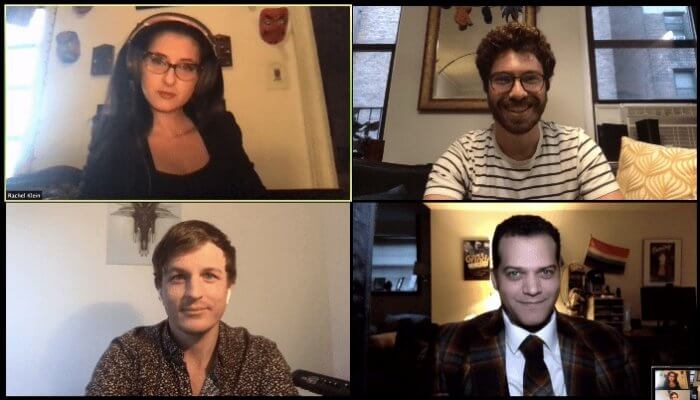
Created during the deep confines of quarantine, the premise treads along the edge of escapist fancy and hard reality. The action is set amongst the remnants of New York City centuries after an apocalypse decimated the world — climate change the likely culprit — with no electricity or internet. The realm is now a city-state called Fiveboro, where five tribes who worship different aspects of 21st century pop culture vie for superiority. It’s their form of religion, a way of life.
The Hepburners are infatuated with the idealized golden age of Hollywood, the Fansci Folk live in a feudal sci-fi cosplay kingdom, the Escandalistas relish the melodrama of the telenovela, the Criterone Collective is obsessed with art films, and the Snookis pattern their lives after sensationalistic reality TV. Can these disparate factions somehow find lasting common ground?
Produced by Iconoclast Theater Collective and David Treatman Creative, the first two episodes of “The World to Come” are now available. According to Ransom, the first season will consist of 12 episodes, roughly 30 minutes each, and will drop throughout the rest of the year. Following are edited excerpts from Gay City News’ online interview with the creators about producing the new work during these dystopian days.
DAVID KENNERLEY: What inspired you to create this audio musical series?
ERIK RANSOM: “The World to Come” is very much a response to the moment at which it was conceived. Back in March at the dawn of the Quarantimes, Rachel, Andy, and I had many contemplative conversations about the state of the industry in which we’d wholly invested our professional lives. Like the vast majority of theater artists, the three of us lost all our prospective projects for the foreseeable future, and we quickly committed ourselves to doing something bold and creative. We sought to fill part of the void created by the closure of live theater venues by conjuring up a brand-new musical highlighting many of our favorite artists. We quickly realized that the limitations of live theater didn’t apply to the medium of the radio play, and so we decided to attempt something truly epic — a sprawling, serialized musical saga.
KENNERLEY: This bold, highly original series is not easy to describe — it’s sort of a hybrid of “Brave New World,” “Mad Max,” and “Game of Thrones,” as produced by Disney. How would you describe it?
RANSOM: Not as well as that! May we quote you? Literally all of those were huge inspirations of mine. But to answer your question: “The World to Come” is a post-apocalyptic story set in New York City, so more than a few of our listeners have drawn the comparison to “Escape from New York.” I would say our version of the future has a bit more whimsy and a lot more belting than John Carpenter’s, but we kind of hang a hat on that. One of the fun things about the world we’ve built is that it’s very referential. For example, the Fansci Folk will casually juxtapose tropes from “Star Trek,” “Game of Thrones,” and “Battlestar Galactica” in a single breath. We’re able to parody specific shows and movies within the confines of the story.
KENNERLEY: In this age of COVID, where live performances are largely forbidden, you have created a world where pop culture entertainment is long lost, yet revered. Can you elaborate?
RACHEL KLEIN: I sort of live in a Kitsch Palace of long-lost artifacts from the recent past, such as a Zsa Zsa Gabor workout video, a “Murder She Wrote” board game, and Elvira memorabilia. The notion of longing to connect to a previous era is something I understand. It’s more liberating than focusing on the present. Our characters are nostalgic for relics from eras that they themselves never experienced, so there is freedom to exaggerate the meaning behind everything, and to carve out a sharp specificity to each character.
KENNERLEY: Between the coronavirus pandemic and the political upheaval in Washington, DC, some days it feels like it’s the end of the world as we know it. Why create a musical set after an apocalypse during these trying times?
ANDY PETERSON: People generally love fantastical tellings of real-life events. That’s why book sales of pandemic-themed literature skyrocketed at the beginning of these Quarantimes. We wanted to put our own spin on the genre, so at a time when governments across the world have neglected their arts sectors, we wanted to create a world in which art is recognized and worshiped as the very essence and identity of a society.
KENNERLEY: What were some of the challenges in creating this series in quarantine isolation?
KLEIN: One was deciding how to structure the entire process. Where to begin? As it turned out, our large cast all had drastically different setups at home, so there was certainly some engineering magic that had to happen. Our recording sessions consisted of the cast meeting in a Zoom room, and reading the scenes with each other while self-recording. It was important that there was still an atmosphere of a proper rehearsal room, so that the actors had scene partners, rather than acting alone in a void, as is often the way with voiceover work.
PETERSON: One of the biggest challenges was the issue of bringing a song to life while all of our musicians and singers record in their separate apartments/ studios all over the country. There’s certainly a lot more back and forth but it also gives our performers the opportunity and freedom to try out new choices that they otherwise might not feel comfortable trying in the room with other people.
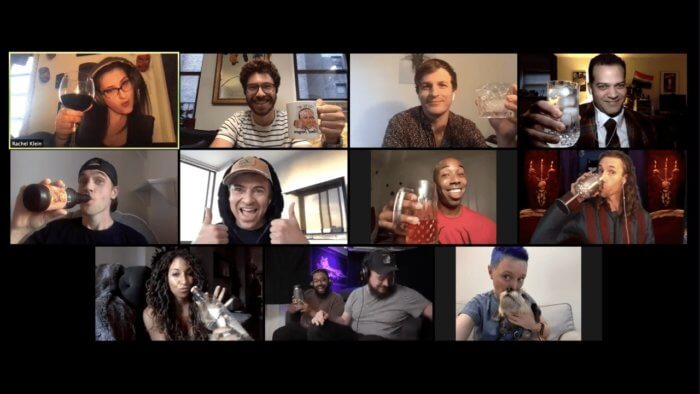
KENNERLEY: The series celebrates the art of storytelling. Was that your intention?
RANSOM: Very much so! The storyteller is the most celebrated vocation in Fiveboro, and for good reason. “The World to Come” allowed us to explore how the kinds of stories we ingest through our screens might survive through the oral tradition. It’s a world where a raconteur holds court in a crowded square recounting the tale of “The Real Housewives of New Jersey” as if it was a Homeric epic. I don’t think we realize how much our entire civilization is shaped around stories. In the Information Age we constantly consume stories whether we’re binging 30 hours of a series on Netflix or watching a 15-second skit on TikTok. Politicians, pundits, journalists — they’re all storytellers — and the stories they tell shape our laws, our foreign policy, and the very fabric of our society. High stakes stuff. Which is why we try to make our story more fun than a lot of what we see in the news these days.
KENNERLEY: Erik, you have revisited historical periods in your work, such as “More Than All the World,” the epic musical about Edward II. How does it feel to leap forward into the future?
RANSOM: Well, it takes a lot less time to write, I’ll tell you that! Research is such a huge part of depicting historical events. Personally, I feel a huge responsibility to any ghost I stir for a story. I work hard to understand them, so I can do my best to paint their lives with as much depth and as many dimensions as possible. It took me years to complete the first draft of “More Than All the World,” which ran about two-and-a-half hours. I was able to write the first draft of Season 1 of “The World to Come,” which runs nearly seven hours, in a little over a month. The process was not without its research component — I had to pore over the geography of the New York City subway map, for instance — but I’ve never had the opportunity to do this much worldbuilding before. A lot of this process was getting tipsy and texting my team in the middle of the night with punny names for post-apocalyptic locales, such as Mudson Yards and Squashington Scare Park.
KENNERLEY: Erik, you often include LGBTQ themes in your work. Without giving away any spoilers, are there any LGBTQ characters in “The World to Come?”
RANSOM: I don’t think it’s safe to assume anyone is straight in a world envisioned by Erik Ransom. I’ve said it before and I’ll say it again — my mission in life is to leave this world a gayer place than I found it! So yes, in “The World to Come” homophobia is largely a thing of the past. The only major culture that holds onto prejudices of today is the Hepburner faction. They worship old black-and-white pictures from the Hays Code era. But I read Vito Russo’s “The Celluloid Closet” when I was a teen, so you can trust that even the Hepburners have a lavender underground hiding in plain sight. Also, on the queer front, one of the main characters in the piece is Teller Bastien, who is non-binary. They hail from The Criterione Collective, which reveres independent films and art cinema. The Collective is a post-gender culture where they/ them pronouns are assumed unless otherwise specified by the individual.
A lot of the work I’m known for is about queerness. “The World to Come” is a bit of a departure insofar as queerness is heavily featured without being the main focus. I wanted to engender a future where queerness in and of itself feels less revolutionary and more incidental. It is post-apocalyptic without being dystopian. It’s a world where the fall of civilization crippled humanity, but we kind of go back to basics. Everyone’s unplugged, people connect sans screens and, when it comes down to it, hope and love rule the day. It doesn’t always feel that way in 2020, so escaping to Fiveboro was a huge part of my self-care routine during the pandemic.
KENNERLEY: Traditional musical theater relies heavily on visuals — sets, costumes, and lighting — to tell the story. Was it a challenge to bring a musical to life in a podcast format?
KLEIN: If you saw our production of “More Than All the World,” then you know how obsessive I am about physical details, expressive staging and lighting, and goth-centric, era-fusing costume aesthetics. When I read a new script, the first thing that begins to appear in my head is how the production will look. I agree that musical theater as a genre is visually charged, and visually charging it even further has always been my candy.
With “The World to Come,” we’ve had to maneuver that way of thinking into an aural-only realm. I still stage every scene; I see it in my head, I place the actors where they would be on stage, design the set and costumes, and, heck, sometimes even the lighting too, so that I have a fully realized theatrical production/ film hybrid in mind’s eye. Then comes the tricky part — bending those images into a tapestry of sound. In collaboration with our absolutely outstanding sound team [Lunoe and Hagerty] we translate the visual to audio. If one of the characters is wearing seven-inch stilettos and one is wearing combat boots and they are walking together over a concrete ground, what does that sound like? Directional panning has helped us to specify location, and each location has a subtle, signature sound to it.
KENNERLEY: During the age of COVID, new forms of theater are emerging, such as “The World to Come.” Would you agree that this might be a silver lining to the pandemic?
PETERSON: An artform is never exciting if it stays stagnant for too long, and sometimes it takes something like a pandemic to push artists to reimagine what an artform is capable of. The creation of shows on Broadway and in musical theater on the whole has generally been restricted by so many factors: theater size, cast size, orchestra size, weekly running costs, the unofficial rule of a two-ish-hour run time, the laws of gravity, etc. This means that theater creators are limited in the type of stories they can tell. Once you take away these restrictions, there is another whole world of stories that the beautiful genre of the musical can explore.
THE WORLD TO COME | Podcast series available for free on theworldtocomemusical.com or platforms like Apple, Spotify, and Google
To sign up for the Gay City News email newsletter, visit gaycitynews.com/newsletter.

